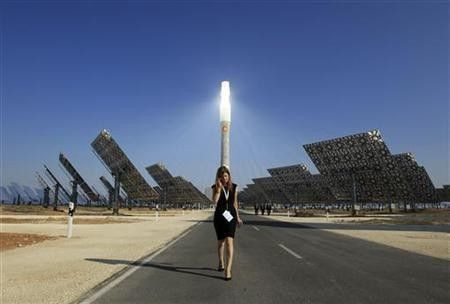Short sellers still see green in battered solar sector

Short sellers who banked on a fall in the price of solar stocks this year pocketed big returns and are already positioning themselves for another go at the battered sector.
Shorts had a field day this year as an oversupply of solar panels sent shares plummeting by more than half and prices for the panels slumped 35 percent. The profits of panel makers such as First Solar Inc (FSLR.O), Suntech Power Holdings Co Ltd (STP.N) and others all fell sharply.
But many shorts still see significant opportunities in the sector, especially among makers of polysilicon, the solar raw material that only recently has entered a pricing meltdown.
More broadly, many solar stocks rallied off recent lows in October in tandem with the broader market, meaning upcoming earnings reports could send them back to their lows.
Only a few short weeks ago I might have said that most of the bad news is in there, but a number of these stocks have had in some cases nearly 100 percent rallies, said Shawn Kravetz, president of Boston-based Esplanade Capital. When third quarter numbers are reported, there is going to be something bad in there for everyone.
Kravetz covered a number of his solar shorts in early October, but has started to rebuild his positions recently, he said, although he declined to be specific.
Solar stocks have long been a favorite of short sellers, who benefit as a stock declines. They borrow shares and sell them with the expectation of buying them back -- or covering their shorts -- at a lower price.
Whereas investors long in solar say the industry is poised for explosive growth as prices on the clean power source become increasingly competitive with fossil fuels, shorts say solar is too dependent on ever-changing government subsidy regimes that have created a fragile boom and bust market.
And what a bust this year has been. Subsidy cuts in top solar markets Italy and Germany, combined with a dramatic increase in production capacity of solar panels, has led to an oversupply of solar panels that has sent prices down. The MAC Global Solar Energy index .SUNIDX is down 63 percent from a 2011 high reached in February, while popular solar stocks such as First Solar and Suntech have experienced more dramatic declines of more than 70 percent from their 2011 highs.
SILVER LININGS
Polysilicon makers, however, have fared better as their primary product was last in the solar supply chain to get hit by a massive price drop. That is changing now, however, as prices have fallen more than 30 percent to about $35 a kilogram from around $50/kg over the summer.
We don't think this industry will bottom until the polysilicon vendors start to break even or lose money, and they are a long long way away from that, said John Segrich, portfolio manager of the Gabelli SRI Green Fund.
For that reason, Segrich's fund is short shares of German polysilicon maker Wacker Chemie AG (WCHG.DE), but also has short positions in companies where there is still profitability left. NV Bekaert SA (BEKB.BR), for instance, which makes sawing wire used to cut silicon wafers.
Polysilicon makers, including South Korea's OCI Co Ltd (010060.KS) and Hong Kong's GCL Poly Energy Holdings Ltd (3800.HK) are also good opportunities for short sellers, Segrich said.
First Solar is also on Segrich's short list, so to speak, and continues to be a particular favorite among short sellers. In the week after the company announced the firing on October 25 of its chief executive, Rob Gillette, short interest in its stock surged 19.4 percent to 18.5 percent of shares outstanding, according to research firm Data Explorers. That coincided with a 14 percent drop in the company's stock, which had already taken a massive beating this year.
First Solar's low-cost cadmium telluride solar panels face increasing competition from ever cheaper silicon-based panels, which are more efficient than First Solar's at transforming sunlight into electricity.
If they really do have a better mousetrap, they will still be around in five years and if they don't, they won't be, said John Hempton, chief investment officer of Bronte Capital. My gut reaction is they probably don't have a better mousetrap.
Hempton covered his short position in First Solar earlier this year. He still has a short position in China's Trina Solar Ltd (TSL.N), however, saying Chinese solar companies' financials are hard to verify and sometimes just plain funky.
Trina raised concerns earlier this year when its audit committee chief, Peter Mak, resigned abruptly.
If you can't trust the Chinese accounts, then you can't tell whether First Solar has a sustainable cost advantage or not, Hempton added.
© Copyright Thomson Reuters 2024. All rights reserved.



















